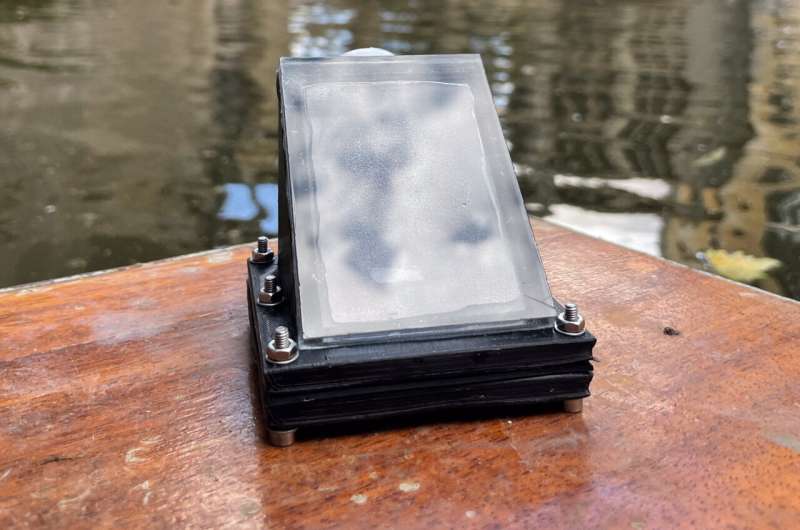This solar marvel turns dirty water into clean H2 fuel & drinkable water.

Estimated reading time: 4 minutes
Table of contents
In a groundbreaking initiative, a team of researchers from the University of Cambridge has developed a revolutionary floating device that utilizes solar power to transform contaminated water, including seawater, into clean hydrogen fuel and purified water. This innovation holds immense promise for regions with limited resources or lacking grid access, as it can operate with any open water source without relying on external power.
Nature-Inspired Innovation
Taking inspiration from the process of photosynthesis in plants, this innovative device marks a significant departure from earlier versions of the ‘artificial leaf.’ While its predecessors could only produce green hydrogen fuel from clean water, this new device operates efficiently with polluted or seawater sources, simultaneously generating clean drinking water.

Overcoming Technical Challenges
The integration of solar fuel production and water purification in a single device posed significant challenges. Dr. Chanon Pornrungroj and Ariffin Mohamad Annuar, co-lead authors of the study, addressed these challenges by designing a device that could operate with contaminated water. They deposited a photocatalyst on a nanostructured carbon mesh, creating a proficient absorber of both light and heat. The porous carbon mesh, treated to repel water, not only aided the photocatalyst’s flotation but also prevented interference from contaminants.
Optimizing Solar Energy Usage
Unlike traditional solar fuel production processes that utilize only a small portion of the solar spectrum, the team’s approach maximizes energy efficiency. A white, UV-absorbing layer on top of the floating device facilitates hydrogen production, while the remaining solar spectrum is transmitted to the bottom, vaporizing water. This unique method mirrors a real leaf’s transpiration process.
Addressing Global Challenges
A device that can simultaneously produce clean fuel and drinking water using solar power alone holds immense potential for addressing global energy and water crises. The World Health Organization reports over three million deaths annually due to indoor air pollution from using ‘dirty’ fuels for cooking. Transitioning to green hydrogen could significantly reduce this number. Additionally, 1.8 billion people lack access to safe drinking water, making the device’s ability to operate in diverse water sources a crucial breakthrough.
Proof of Principle with Global Implications
The researchers emphasize that while their device remains a proof of principle, its versatility and tolerance for pollutants make it a promising solution for a variety of environments. Professor Erwin Reisner, who led the research, envisions such innovations as essential for developing a circular economy and a sustainable future. The device’s potential impact on climate, pollution, and health issues underscores its importance in addressing multifaceted global challenges.
The hybrid photothermal-photocatalyst sheets developed by the University of Cambridge researchers represent a significant leap towards sustainable water splitting and purification. Their groundbreaking device not only demonstrates versatility in water sources but also holds the promise of a cleaner, more sustainable future, bridging the gap between energy and water challenges. As the world grapples with environmental crises, innovations like these pave the way for transformative solutions.
How does it work?
- Sunlight capture: A specially designed photocatalyst material on the device’s surface absorbs sunlight.
- Water splitting: The absorbed energy triggers the splitting of water molecules into hydrogen and oxygen.
- Hydrogen collection: Separated hydrogen gas is collected and can be used as a clean fuel source.
- Water purification: Remaining oxygen reacts with other pollutants in the water, purifying it and making it safe for drinking or other uses.
The potential impact of this technology is vast:
- Providing clean water to underserved communities: The device can offer an off-grid solution for areas facing water scarcity or contamination, helping millions gain access to safe drinking water.
- Decarbonizing transportation and energy: Hydrogen fuel generated by the device can power vehicles and fuel cells, contributing to a cleaner and more sustainable energy future.
- Reducing pollution: By treating wastewater and utilizing it for fuel production, the device can mitigate water pollution and contribute to a circular economy.
While still in its early stages of development, this revolutionary solar-powered device has the potential to revolutionize how we approach water and energy challenges. It offers a glimpse into a future where clean water and renewable energy are accessible to all, powered by the sun’s boundless energy.






Responses